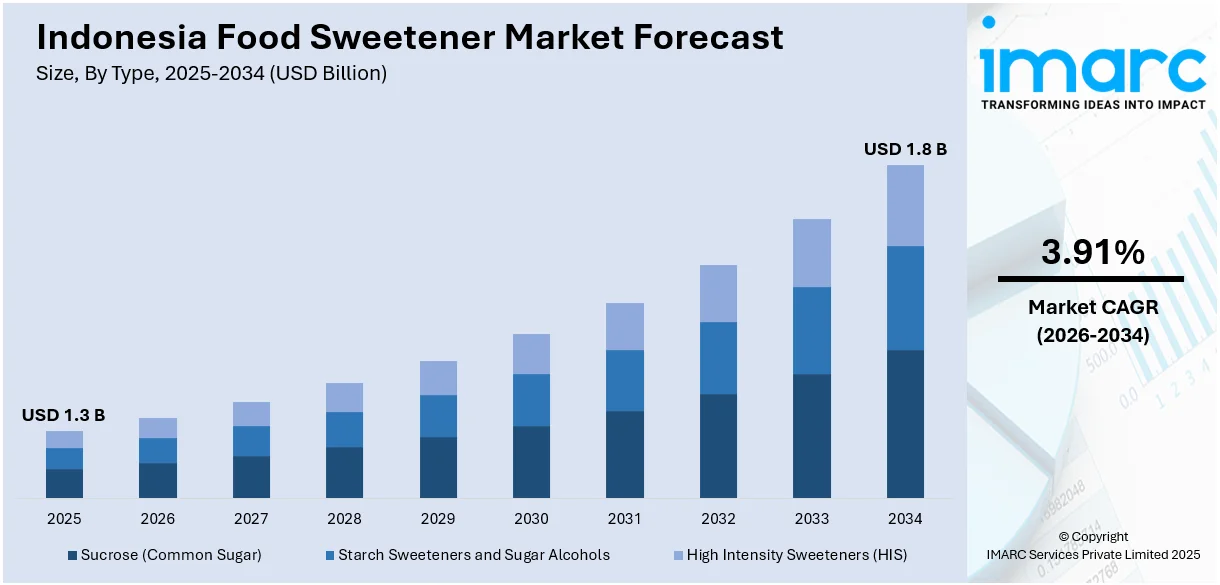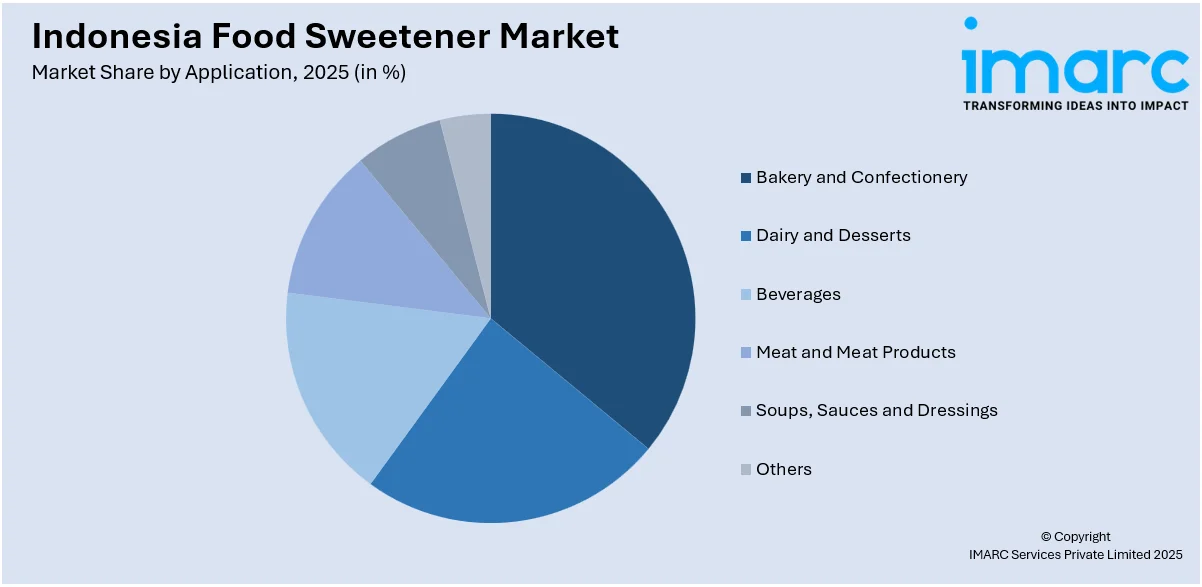
Indonesia Food Sweetener Market Size, Share, Trends and Forecast by Type, Application, and Region, 2026-2034
Market Overview:
Indonesia food sweetener market size reached USD 1.3 Billion in 2025. Looking forward, IMARC Group expects the market to reach USD 1.8 Billion by 2034, exhibiting a growth rate (CAGR) of 3.91% during 2026-2034. The rising health consciousness among the masses, favorable governmental initiatives to reduce sugar consumption, increasing prevalence of lifestyle diseases like diabetes and obesity, and rapid growth in the food and beverage industry represent some of the key factors driving the market.
|
Report Attribute
|
Key Statistics
|
|---|---|
|
Base Year
|
2025
|
|
Forecast Years
|
2026-2034
|
|
Historical Years
|
2020-2025
|
| Market Size in 2025 | USD 1.3 Billion |
| Market Forecast in 2034 | USD 1.8 Billion |
| Market Growth Rate 2026-2034 | 3.91% |
Food sweeteners are substances added to various food and beverage products to impart sweetness. Existing in both natural and artificial forms, these sweeteners serve as alternatives to sugar. Naturally occurring sweeteners like honey, maple syrup, and agave are derived from plants and animal products. On the other hand, artificial sweeteners, such as aspartame, saccharin, and sucralose, are synthesized through chemical processes. They play an essential role in the food industry, especially in the formulation of products designed for consumers who are managing diabetes, obesity, or other metabolic conditions. Regulatory agencies like the U.S. Food and Drug Administration (FDA) and the European Food Safety Authority (EFSA) are rigorously evaluating these substances to ensure their safety for consumption. They are also utilized to improve the taste profile of low-calorie or sugar-free food and beverage offerings, including diet sodas, sugar-free snacks, and reduced-sugar baked goods. In recent years, food sweeteners have gained immense traction across Indonesia as they enable manufacturers to meet the demands for healthier options while maintaining palatability.

To get more information on this market Request Sample
Indonesia Food Sweetener Market Trends:
The Indonesia food sweetener market is experiencing robust growth, driven by the rising health consciousness among consumers. As awareness about the adverse effects of high sugar consumption intensifies, people are increasingly seeking alternative sweetening options. This shift in consumer behavior is catalyzing the demand for natural and artificial sweeteners, thereby augmenting market growth. Additionally, the growing prevalence of lifestyle-related health conditions, such as diabetes and obesity, is accelerating the product adoption rate as healthcare professionals recommend reduced sugar intake for managing these conditions. In line with this, several favorable initiatives undertaken by the Indonesian government to limit sugar consumption by imposing sugar taxes are further supporting market growth. Moreover, the rapid growth in the food and beverage industry across the country is creating a positive market outlook. Due to the significant expansion of urban areas, westernization of diets, and inflating disposable incomes, the consumption of processed foods and drinks is escalating. Consequently, manufacturers are continuously incorporating food sweeteners to offer low-calorie and sugar-free variants that appeal to health-conscious consumers, thus fueling market growth. Furthermore, ongoing innovation in product formulation is another major growth-inducing factor. Companies are heavily investing in research and development (R&D) activities to create new types of food sweeteners with fewer side effects and better taste profiles. This includes exploring indigenous natural sources or employing advanced technologies to develop synthetic alternatives. Besides this, trade liberalization and globalization are fostering market growth owing to easier import regulations, which are widening consumer choice and escalating competition. This, coupled with stricter safety and quality standards by regulatory bodies like the Indonesian National Agency of Drug and Food Control (BPOM) that ensure consumer safety and product credibility, is propelling the market growth.
Indonesia Food Sweetener Market Segmentation:
IMARC Group provides an analysis of the key trends in each segment of the market, along with forecasts at the country level for 2026-2034. Our report has categorized the market based on type and application.
Type Insights:
- Sucrose (Common Sugar)
- Starch Sweeteners and Sugar Alcohols
- Dextrose
- High Fructose Corn Syrup (HFCS)
- Maltodextrin
- Sorbitol
- Others
- High Intensity Sweeteners (HIS)
- Sucralose
- Aspartame
- Stevia
- Others
The report has provided a detailed breakup and analysis of the market based on the type. This includes sucrose (common sugar), starch sweeteners and sugar alcohols (dextrose, high fructose corn syrup (HFCS), maltodextrin, sorbitol, and others), and high intensity sweeteners (HIS) (sucralose, aspartame, stevia, and others).
Application Insights:

Access the comprehensive market breakdown Request Sample
- Bakery and Confectionery
- Dairy and Desserts
- Beverages
- Meat and Meat Products
- Soups, Sauces and Dressings
- Others
A detailed breakup and analysis of the market based on the application have also been provided in the report. This includes bakery and confectionery, dairy and desserts, beverages, meat and meat products, soups, sauces and dressings, and others.
Regional Insights:
- Java
- Sumatra
- Kalimantan
- Sulawesi
- Others
The report has also provided a comprehensive analysis of all the major regional markets, which include Java, Sumatra, Kalimantan, Sulawesi, and Others.
Competitive Landscape:
The market research report has also provided a comprehensive analysis of the competitive landscape in the market. Competitive analysis such as market structure, key player positioning, top winning strategies, competitive dashboard, and company evaluation quadrant has been covered in the report. Also, detailed profiles of all major companies have been provided.
Indonesia Food Sweetener Market Report Coverage:
| Report Features | Details |
|---|---|
| Base Year of the Analysis | 2025 |
| Historical Period | 2020-2025 |
| Forecast Period | 2026-2034 |
| Units | Billion USD |
| Scope of the Report | Exploration of Historical and Forecast Trends, Industry Catalysts and Challenges, Segment-Wise Historical and Predictive Market Assessment:
|
| Types Covered |
|
| Applications Covered | Bakery and Confectionery, Dairy and Desserts, Beverages, Meat and Meat Products, Soups, Sauces and Dressings, Others |
| Regions Covered | Java, Sumatra, Kalimantan, Sulawesi, Others |
| Customization Scope | 10% Free Customization |
| Post-Sale Analyst Support | 10-12 Weeks |
| Delivery Format | PDF and Excel through Email (We can also provide the editable version of the report in PPT/Word format on special request) |
Key Benefits for Stakeholders:
- IMARC’s industry report offers a comprehensive quantitative analysis of various market segments, historical and current market trends, market forecasts, and dynamics of the Indonesia food sweetener market from 2020-2034.
- The research report provides the latest information on the market drivers, challenges, and opportunities in the Indonesia food sweetener market.
- Porter's five forces analysis assist stakeholders in assessing the impact of new entrants, competitive rivalry, supplier power, buyer power, and the threat of substitution. It helps stakeholders to analyze the level of competition within the Indonesia food sweetener industry and its attractiveness.
- Competitive landscape allows stakeholders to understand their competitive environment and provides an insight into the current positions of key players in the market.
Key Questions Answered in This Report
The food sweetener market in Indonesia was valued at USD 1.3 Billion in 2025.
The Indonesia food sweetener market is projected to exhibit a CAGR of 3.91% during 2026-2034, reaching a value of USD 1.8 Billion by 2034.
The Indonesia food sweetener market is driven by rising health consciousness, growing demand for low-calorie products, and increasing prevalence of lifestyle diseases. Changing dietary habits and a rise in processed food consumption are contributing to the market growth. Additionally, innovations in food products and supportive government regulations further encourage the adoption of alternative sweeteners across various consumer segments.
Need more help?
- Speak to our experienced analysts for insights on the current market scenarios.
- Include additional segments and countries to customize the report as per your requirement.
- Gain an unparalleled competitive advantage in your domain by understanding how to utilize the report and positively impacting your operations and revenue.
- For further assistance, please connect with our analysts.

 Request Customization
Request Customization
 Speak to an Analyst
Speak to an Analyst
 Request Brochure
Request Brochure
 Inquire Before Buying
Inquire Before Buying




.webp)




.webp)












